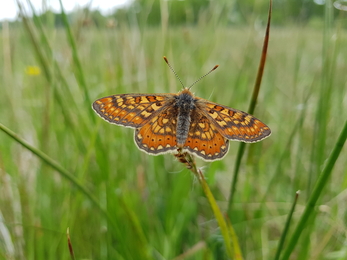© Lianne de Mello
Marsh fritillary reintroduction
The last marsh fritillary butterfly disappeared from north Hampshire's meadows in 1996, but an exciting new partnership is working to return the species to its former haunts.
The marsh fritillary is one of our most bright and beautiful butterflies, and was once widespread across Britain. However like many pollinators, the species suffered from years of habitat loss and degradation, and locally went extinct two decades ago.
However with the generous support of HIWWT and Butterfly Conservation members, the Farnborough Airport Community Environmental Fund, the Ministry of Defence and the John Spedan Lewis Foundation, and by working with local experts from the Hampshire Marsh Fritillary Action Group (HMFAG), a project is underway to use healthy populations elsewhere in the UK to reintroduce the marsh fritillary to suitable Trust-managed sites in north Hampshire.
© Sue Clarke
A radical reintroduction plan
A two year captive breeding and release programme formally began in September 2016, with the careful collection of 300 marsh fritillary caterpillars from several strong colonies in Dartmoor, Devon.
They have since been transferred to experienced captive breeders in Hampshire and Buckinghamshire. These breeders are supporting the caterpillars as they grow and pupate.
© Andy Barker
The first generation was released successfully in the spring of 2018. We hope to release several generations of larvae onto a Trust-managed meadow complex in north Hampshire over the period to spring 2019.
This ambitious plan is not without its risks. Marsh fritillary populations are notoriously volatile and subject to local colony extinctions. However the combined expertise of The Wildlife Trusts, Butterfly Conservation, and HMFAG mean that through creating networks of suitable habitats, we’ll give them the best possible chance of establishing a resilient new marsh fritillary population in north Hampshire.
Support marsh fritillary butterflies
Together we can continue to protect wild havens for this beautiful species.
Support our work to protect marsh fritillary butterflies and other species across our counties by donating to our conservation work.


